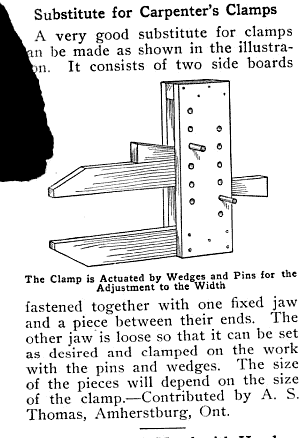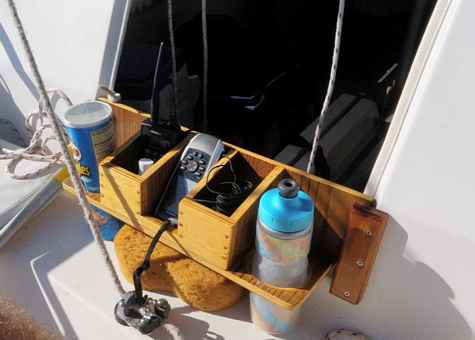
 Custom Search
|
| boat plans |
| canoe/kayak |
| electrical |
| epoxy/supplies |
| fasteners |
| gear |
| gift certificates |
| hardware |
| hatches/deckplates |
| media |
| paint/varnish |
| rope/line |
| rowing/sculling |
| sailmaking |
| sails |
| tools |
| join |
| home |
| indexes |
| classifieds |
| calendar |
| archives |
| about |
| links |
| Join Duckworks Get free newsletter CLICK HERE |
|
|
| November Treasure Chest |
Two Quick Ideas
Just finished some finicky painting on our Rozinante and had great success using electrical tape for masking curved surfaces, boot and cove stripes. Makes a fine edge, no problem peeling it off after a day or two. I used 3M Tartan/Colorflex products but suspect that any good quality vinyl tape would do.
Regarding WEST epoxy, I use 10mL disposable syringes. Remove the plunger, drill out the diameter of the tip a bit, use the pump to deliver 1 ml hardener then add resin up to the 6mL mark for the 1:5 ratio. So I use it as a small graduated cylinder, then replace the plunger and apply where necessary. Microballoons or silica thickener mixtures can be squeezed out with no problem as well. Dispo syringes are cheap. Larger ones are of course available for more $.
The same syringe trick works for small amounts of SikaFlex or other polyurethane goop. Take out the plunger, fill about 3/4 full, replace plunger and then use for bedding hardware, screws etc. Re-plug Sikaflex tube. Eventually it starts setting up in the "mother tube", so I leave the stuck cap on and punch a small hole in the cartridge body, pump out the 8 mls or so into the syringe, release the pressure and reseal the hole with a piece of tape. Next time, punch a new hole. etc.. This works for many months, at least for me.
George
The Simplest Things
Sometimes it’s the simplest things that make all the difference.
Take for instance my West Wight Potter 15’. It’s a great little boat. I took it down to the Florida 120 in May 2015 and it was only one of twelve boats that completed the entire course. I was suitably impressed. But I learned something in the process. While the Potter proved to be an incredibly comfortable little pocket cruiser, I was forever losing track of small items in its “spacious” cabin. VHF, cell phone, sun screen, etc. – I would toss it below for safe keeping only to have such items migrate to the most inaccessible points imaginable.
So before I embarked on the Outer Banks 130 (OBX130) in August, I decided that I needed to come up with a more convenient option. Enter the “glove compartment”. It makes perfect sense. Every automobile has one – it’s the virtual junk drawer of the roadways. All of those small random items that you might routinely need are neatly tucked away but always readily accessible at a moment’s notice.
Fortunately, I had recently built a new hatch to replace the rather shoddy one constructed by my boat’s previous owner. Hence I had the plywood scraps from the old hatch sitting unused in the corner of the garage.
Old hatch, and new hatch. |
A few quick measurements, a spot of glue, left over ring nails and a few coats of varnish and my “glove compartment” quickly became reality.
Ta da! The “Glove Compartment”! |
Installed |
On the recent OBX130, it proved to be remarkably convenient. No more scrounging about in the cabin looking for small electronics. No more coffee cups and water bottles ricocheting about the cockpit on every tack. The only modification I could suggest would be to drill several holes in the back plate to provide a spot to tie down all of my various gizmos and whatnots to prevent loss in the event of an unfortunate capsize.
In use |
Best of all, its easily removable when not needed or desired. Total cost: A few stray hours and left-over materials that were just collecting dust. Looking back, I realize that just about every boat that I have ever owned could have benefited from a similarly convenient collection of cubby holes.
The simplest things. Gotta love ‘em!
Fair winds!
Shawn “Lawless” Payment
WWP15 #1823 “Bandit
Johns Island, SC
Loading Ramps For Pick-Up Boats
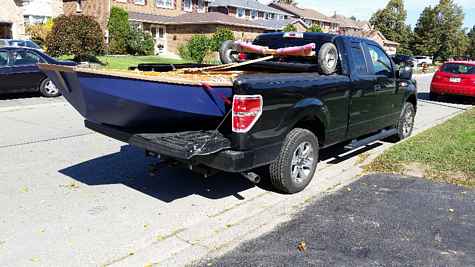 |
I have a couple of Mirror Dinghies that I really love to sail – they are great little boats and fit in the back of my pick-up truck. I generally sail them on my own and simply use a home-made dolly to get them from the truck to the water.
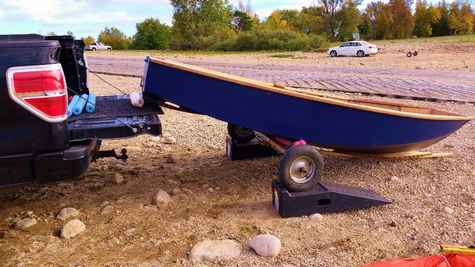 |
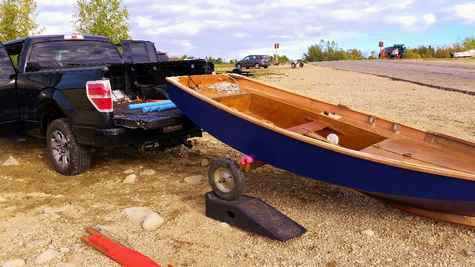 |
The only part I have some difficulty with is hoisting the boat from the dolly up a couple of feet to the tailgate by myself. You obviously can’t stand directly behind the boat to lift it as you’d be in between the boat and the tailgate – so you have to do it from one side. Do-able but not easy. I thought about making or buying some ramps – the type you load an ATV into a truck with but the angle was too steep to push the boat and dolly up. Then I had a little brainwave (little brain…). I borrowed a set of car ramps (the kind you use to do oil changes) from a friend at work and now just roll the dolly up onto those.
This gets the transom of the boat just above the height of the tailgate. I put a boat fender and some pool noodles on the tailgate of the truck and use them for rollers. Now all I do is lift the bow of the boat and give it a push and she slides right in on the rollers. The fender works best for the roller – the noodles will roll but get flattened out after a while – they’re really there to provide some extra cushioning for the hull.
I’m going to make a set of these ramps out of plywood – they’re going to be nesting so that they fit inside each other and take up less space. Further I’m going to attach two ropes between the ramps – one at the front and one at the back of the ramps– the exact width of the dolly to save me lining up the ramps with the tires.
Once the boat’s in place I tie the dolly on the top of the truck bed rails. The funny thing is I made the dolly in about 1985 – to the perfect width measurement of my current day pick-up truck – Don’t ya love it when things work out?
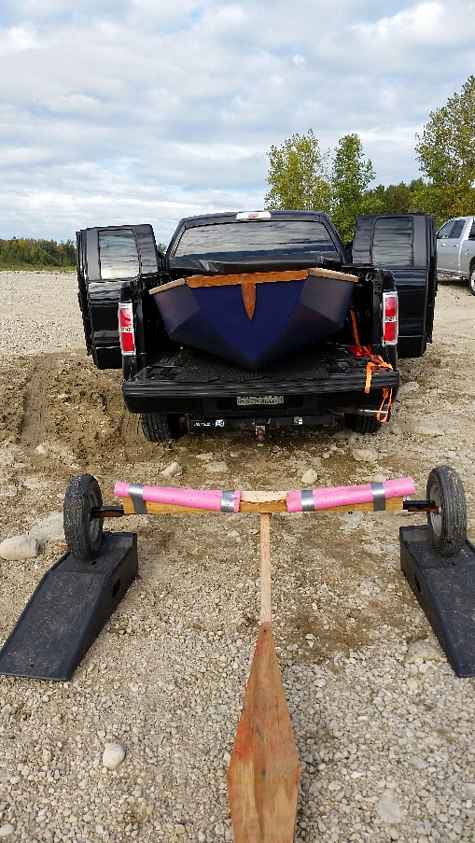 |
Kelly Trafford
ST Blade Battery Terminal Mount Fuse Block Kit
I found this while trying to figure out how I am going to run the Nav lights on my Hunter 20. The boat is a 1984 model and apparently did not come with an electrical system from the factory. What a previous owner wired up was junk and that is all out now. I got a Sea Dog 3 switch panel from you but think I may add another one. That led me on a search for bus bars. That's when I found this product.

By running 10AWG wire and fusing it with a 30amp fuse the wiring from the battery is protected and also the battery. You could run fuse protected main lines or individual circuits to up to four locations anywhere on the boat. Simple and inexpensive.
Andrew Ness
FG Sleeving

Experimenting with some biaxial FG sleeving. Followed along with the demo video and got very good - better, really, than expected - results with the first experiment. Maybe another experiment with the larger, heavier sleeving... and then try to figure out how much epoxy I'll need to do an 18' mast! The mast may wait until I order Duckypoxy to get its UV protective characteristics. Thanks for these products Chuck.
Bob
Lakewiz.com Announces FishermanGuy - Mobile App Fishing and Boating Accessories
Lakewiz.com announces the second in a series of mobile apps for fishing and boating enthusiasts. This app is for the fisherman who wants to place GPS “buoys” marking their prime fishing spots.
Tom Davidson, President of Lakewiz explains, “We have designed FishermanGuy for geeks who like to fish! Anyone who wants to record a journey drawn on a map in a quantifiable, affordable tool will benefit from our app. It helps you to go back to that great fishing spot you found.”
- The Trip feature allows you to record waypoints on a map to location, date and time, speed and course. You can access a history of those waypoints to return to a location.
- The Speed and Heading feature, unlike the notoriously inaccurate speedometers found on most boats, provides a GPS-based speedometer in large, easy-to-read in text.
FishermanGuy and PowerboatGuy are available for iPhone and iPad through the Apple App store. More information is available by visiting: www.lakewiz.com
To comment on Duckworks articles, please visit one of the following:
|
 |




